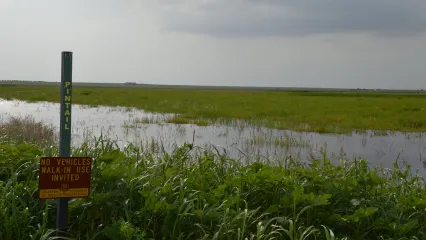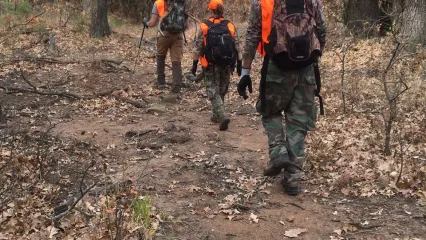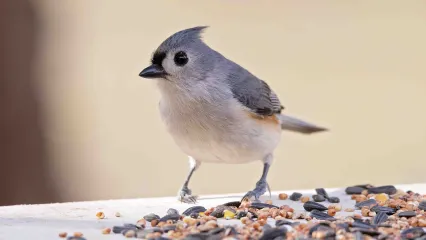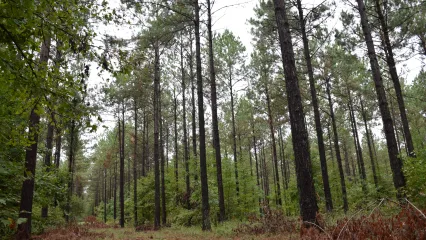Attention Non-Residents
The Oklahoma Wildlife Conservation Commission adopted new rules in 2025 that require non-residents accessing certain Oklahoma public hunting and fishing areas to check in and out of the area. By checking in and out of these areas, hunters, anglers, shooters, birdwatchers, hikers and any other users can help the Wildlife Department better understand how the area is being used. There is no additional cost associated with checking in or out of an area. There is no limit to the number of check ins for an individual in a year.

Contacts
Area Details
Hackberry Flat WRP covers 4,000 acres of southwestern Tillman County in Western Oklahoma. Located southeast of the town of Frederick, Hackberry Flat WMA is a combination of upland and wetland habitats.
The 3,700 acre wetland development unit consists of a variety of plants such as millet, sedges, and smartweed, and some agriculture fields. Uplands consist of agriculture fields, native grasses, improved grasses, and forbs, interspersed with mesquite, hackberry, Osage orange, black locust, and sand plum. The average annual precipitation for the area is approximately 27 inches.
Most water in wetland units comes from rainfall runoff. Rainfall amounts in this region greatly fluctuate between years; therefore, the number of wetland units flooded at any given time is highly variable.
Hackberry Flat WMA is also home to the Hackberry Flat Center.
If you're an educator, consider taking your students on a field trip to explore the Outdoor Classrooms at Hackberry Flat. Each year, a total of 20 grants are available to help cover travel costs. Discover more about this exciting opportunity!
From Frederick: 1 mile South on U.S. Hwy 183, 3 miles east on E1830, 5 miles south on N2240, east on Benson Rd (E1880) into area. Or, continue another mile south on N2240, east on Crawford Rd (E1890) to Center.
- Waterfowl: Ducks are usually present in good numbers but fluctuate throughout the hunting seasons. Geese are usually not as abundant.
- Dove: Dove are usually present in good numbers but are highly sought after.
- Quail: Bobwhite quail are present in low numbers in upland areas.
- Sandhill Crane: Available occasionally during fall migration.
- Rabbit: Both cottontails and jackrabbits are found, but cottontails are more common.
- Furbearers: Coyote, bobcat and raccoon are available.
- Shorebirds: Hackberry offers one of the best areas to view shorebirds in the region. The best viewing time for observing these species is during spring migration. Twenty-nine different shorebird species have been identified at Hackberry Flat WMA.
- Wading Birds, etc.: A wide variety of wetland birds are found. Although most abundant in spring and early fall, wetland birds can be observed in all seasons.
- Raptors: Peregrine Falcons are observed during spring and fall migration. Ferruginous hawk, rough-legged hawk and prairie falcon are frequently observed during winter.
Approximately 90 water control structures, 35 miles of dikes, 4 miles of water distribution canals and 25 wetland units have been constructed to provide wetland wildlife habitat. In addition, there is a pipeline that delivers 2,400 acre/feet of water annually to Hackberry Flat. Management efforts focus on producing native wildlife foods such as wild millets, sedges, smartweeds, pigweeds, ragweeds and sunflower. Agriculture crops such as milo, foxtail millet, Japanese millet, and wheat are planted on approximately 1,300 acres annually. These fields are planted for both dove and waterfowl feeding fields.
One designated primitive camping area is offered on the area. Both lodging and restaurants are available in Frederick. The Frederick Chamber of Commerce can be reached at (580) 335-2126.
Near by Lake Fredrick offers fair fishing opportunities.
All shotgun hunting is restricted to federally approved nontoxic shot.
Closed Seasons
Seasons w/ Special Restrictions
- Deer Archery, Dove, Rail, Gallinule, Crow, Quail, Snipe, Rabbit, Squirrel, Woodcock, Pursuit with Hounds for Furbearers, Predator/Furbearer Calling
Closed Oct. 15 - Jan. 31.
- Duck, Merganser and Coot
Closed Oct. 15 - Jan. 31. Hunting hours for waterfowl close at 1 p.m. daily.
Closed to all air-driven watercraft.
Public access is prohibited from Oct. 15 - Jan. 31, unless otherwise provided.
No camping allowed.
Altus Chamber of Commerce
PO Box 518
Altus OK 73522
580-482-0210
altuscc@intplsrv.net
Frederick Chamber of Commerce
105 South Main
Frederick OK 73542
580-335-2126
http://frederickokchamber.org/
Great Plains Country
114 South 9th St, Suite A Frederick OK 73542
580-335-5999
gpc@greatplainscountry.com
www.greatplainscountry.com
Oklahoma Tourism and Recreation Department
Post Office Box 52002
Oklahoma City, OK 73152-2002
(800) 652-6552 or (405) 521-2409
www.travelok.com
Apprentice Designation: A Learner's Permit for Hunting
Hunter education has greatly reduced hunting accidents, but if you can’t complete a course right away, the apprentice designation allows you to hunt under supervision. It works like a learner’s permit, giving you the chance to gain real experience safely until you finish hunter education.
Exploring the New Herron Family WMA
The new Herron Family WMA is more than 17,000 acres of hunting land, it is also adventure, access, conservation, and tradition. Thanks to a unique partnership, Oklahoma residents now have a new place to chase deer, call turkeys, hear quail, and pass on the outdoors to the next generation.


